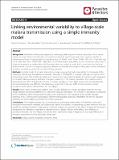Linking environmental variability to village-scale malaria transmission using a simple immunity model
Author(s)
Bomblies, Arne; Laminou, Ibrahim M; Duchemin, Jean-Bernard; Yamana, Teresa K.; Eltahir, Elfatih A. B.
Download1756-3305-6-226.pdf (2.014Mb)
PUBLISHER_CC
Publisher with Creative Commons License
Creative Commons Attribution
Terms of use
Metadata
Show full item recordAbstract
Background:
Individuals continuously exposed to malaria gradually acquire immunity that protects from severe disease and high levels of parasitization. Acquired immunity has been incorporated into numerous models of malaria transmission of varying levels of complexity (e.g. Bull World Health Organ 50:347, 1974; Am J Trop Med Hyg 75:19, 2006; Math Biosci 90:385–396, 1988). Most such models require prescribing inputs of mosquito biting rates or other entomological or epidemiological information. Here, we present a model with a novel structure that uses environmental controls of mosquito population dynamics to simulate the mosquito biting rates, malaria prevalence as well as variability in protective immunity of the population.
Methods:
A simple model of acquired immunity to malaria is presented and tested within the framework of the Hydrology, Entomology and Malaria Transmission Simulator (HYDREMATS), a coupled hydrology and agent-based entomology model. The combined model uses environmental data including rainfall, temperature, and topography to simulate malaria prevalence and level of acquired immunity in the human population. The model is used to demonstrate the effect of acquired immunity on malaria prevalence in two Niger villages that are hydrologically and entomologically very different. Simulations are conducted for the year 2006 and compared to malaria prevalence observations collected from the two villages.
Results:
Blood smear samples from children show no clear difference in malaria prevalence between the two villages despite pronounced differences in observed mosquito abundance. The similarity in prevalence is attributed to the moderating effect of acquired immunity, which depends on prior exposure to the parasite through infectious bites - and thus the hydrologically determined mosquito abundance. Modelling the level of acquired immunity can affect village vulnerability to climatic anomalies.
Conclusions:
The model presented has a novel structure constituting a mechanistic link between spatial and temporal environmental variability and village-scale malaria transmission. Incorporating acquired immunity into the model has allowed simulation of prevalence in the two villages, and isolation of the effects of acquired immunity in dampening the difference in prevalence between the two villages. Without these effects, the difference in prevalence between the two villages would have been significantly larger in response to the large differences in mosquito populations and the associated biting rates.
Date issued
2013-08Department
Massachusetts Institute of Technology. Department of Civil and Environmental EngineeringJournal
Parasites & Vectors
Publisher
BioMed Central Ltd
Citation
Yamana, Teresa K et al. “Linking Environmental Variability to Village-scale Malaria Transmission Using a Simple Immunity Model.” Parasites & Vectors 6.1 (2013): 226.
Version: Final published version
ISSN
1756-3305